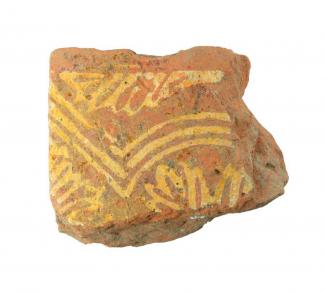Floor tile fragment
Medieval, about 1396
Found on the site of Hyde Abbey in the garden of 8, King Alfred Place, Winchester, Hampshire in 1996
Glazed inlaid floor tile fragment with a pattern of intersecting circles and a floral centre. This design is found on complete tiles in Winchester Cathedral and in Winchester College audit room, having been previously in the vestry there. Records from the College note the purchase of 8000 tiles with this and a number of other designs for the vestry from William Tylere of Otterbourne, south of Winchester, in 1396. The white clay used for inlay came from Farnham, the red clay being obtained from the Otterbourne claybeds. This tile fragment is evidence that Hyde Abbey also purchased tiles made at Otterbourne about this time. Presumably the tile was broken in the destruction which followed the surrender of Hyde Abbey to Thomas Wriothesley, Henry VIII's Commissioner for the dissolution of Hampshire's monasteries in 1538.



